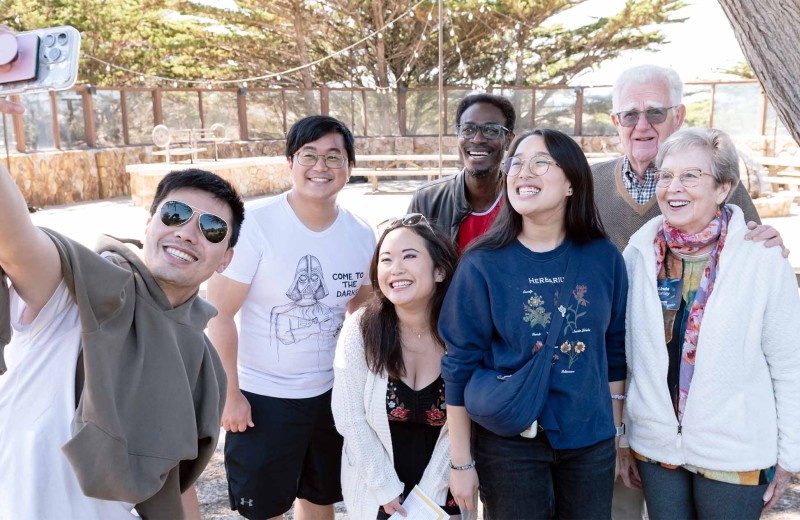Gladstone NOW: The Campaign Join Us on the Journey✕

William J. Rutter was a pioneering force in biomedicine whose vision shaped San Francisco’s Mission Bay neighborhood into a hub for innovation and discovery.
William J. Rutter, PhD, a loyal Gladstone Institutes supporter and biotechnology pioneer who was a catalyst for transforming San Francisco’s Mission Bay neighborhood into a thriving biomedical hub, passed away on July 11. He was 96.
A renowned biochemist and entrepreneur, Rutter’s bold ideas and collaborative spirit transformed UC San Francisco (UCSF) and helped forge the strong research alliance between UCSF and Gladstone that continues today. Rutter continuously advocated for Gladstone’s presence and prominence in Mission Bay and served as a mentor for countless Gladstone scientists.
“Bill’s vision for Mission Bay, and his belief in the power of institutions like Gladstone to contribute to it, shaped Gladstone’s trajectory in the most positive ways,” says Robert Mahley, MD, PhD, president emeritus and founder of Gladstone. “He had an uncanny ability to see not just what science was, but what it could become—and how to create the environment to make it thrive.”
Rutter’s decades-long career left an indelible mark on the life sciences, not only through his scientific discoveries, but also through his visionary approach to building institutions, nurturing talent, and integrating academia with industry. He believed that scientific discovery could have real-world impact, and that bringing together people from different sectors would accelerate progress.
“Bill’s vision for Mission Bay, and his belief in the power of institutions like Gladstone to contribute to it, shaped Gladstone’s trajectory in the most positive ways.”
Putting UCSF on the Map as a Scientific Powerhouse
Recruited from the University of Washington, Rutter joined UCSF in 1968 as founding chair of the Department of Biochemistry and Biophysics, when the university was at a crossroads. With a clear vision for the future of molecular biology, he set out to revitalize a department that had been without leadership for six years.
Partnering with Gordon Tomkins, a respected molecular endocrinologist from the National Institutes of Health (NIH), who joined as vice chair, they recruited a generation of promising scientists and began to build a new kind of research environment focused on collaborative science with small labs and interactive teams. Rutter’s leadership helped define a new model for scientific discovery at UCSF—one built on deep collaboration and a commitment to excellence. His strategic thinking and drive for innovation transformed not just a department, but the culture and aspirations of the entire institution.
“Without Bill Rutter, the biotechnology revolution may not have taken root in San Francisco the way it did,” says Deepak Srivastava, MD, president of Gladstone. “He had a rare ability to bridge ideas and institutions, and he never stopped championing a scientific community defined by excellence and collaboration.”
Rutter nurtured a culture of innovation that would come to define UCSF, positioning it at the forefront of academic biomedical research in the U.S.
Advancing Public Health Through Innovation
In 1981, Rutter co-founded Chiron Corporation, which quickly became a leader in the emerging biotechnology field, demonstrating the promise of recombinant DNA technology to create medicines.
The company developed the first recombinant hepatitis B vaccine and played a central role in identifying, sequencing, and cloning the hepatitis C virus—achievements that led to better diagnostics and treatments for millions worldwide. These breakthroughs helped launch the biotech industry and underscored Rutter’s belief in the power of science to serve society.
Championing Mission Bay and Gladstone’s Role in It
Long after his official retirement from UCSF, Rutter remained a powerful force for its future. He was a key driver in the vision and creation of UCSF’s Mission Bay campus, where he saw the potential to unite research, clinical care, and industry in one dynamic space.
As chair of the fundraising campaign and through his leadership of the Bay Area Life Sciences Alliance, he brought that vision to life. He also strongly advocated for the inclusion and long-term presence of Gladstone at Mission Bay, recognizing the value of integrating independent research organizations into the academic and biotech environment.
In 2007, UCSF named one of Mission Bay’s first major buildings the William J. Rutter Center, in honor of his extraordinary contributions to the university and the broader life sciences community.
“He had a rare ability to bridge ideas and institutions, and he never stopped championing a scientific community defined by excellence and collaboration.”
Rutter’s Legacy Lives On
Throughout his career, Rutter authored hundreds of scientific papers, held more than two dozen patents, and was elected to the National Academy of Sciences and the American Academy of Arts and Sciences. But his most enduring legacy may be the institutions he built and the generations of scientists he inspired.
“Bill’s passing leaves a profound void, but also a powerful legacy,” Mahley reflects.
His work helped launch UCSF into national prominence and his leadership catalyzed an entire industry. His belief in the role of science to serve society continues to shape the community he helped create at Mission Bay.
“Bill’s influence will be felt for generations—in the discoveries made possible by the institutions he shaped, and in the ongoing work of those who carry his vision forward,” Srivastava says.
From Mentorship to Legacy: Creating Opportunity for Early Career Scientists
From Mentorship to Legacy: Creating Opportunity for Early Career Scientists
Robert and Linda Mahley’s commitment to trainee development continues through Gladstone’s annual Career Advancement Awards.
Graduate Students and Postdocs HistoryGladstone Mourns the Loss of Founding Trustee Richard D. Jones
Gladstone Mourns the Loss of Founding Trustee Richard D. Jones
Jones lent Gladstone his time and expertise for nearly 50 years.
History Institutional NewsGrowing Together: Deepak Srivastava Marks 20 Years at Gladstone
Growing Together: Deepak Srivastava Marks 20 Years at Gladstone
As Deepak Srivastava celebrates two remarkable decades at Gladstone, we revisit key career milestones and look forward to the future he continues to shape.
History Institutional News Srivastava Lab



